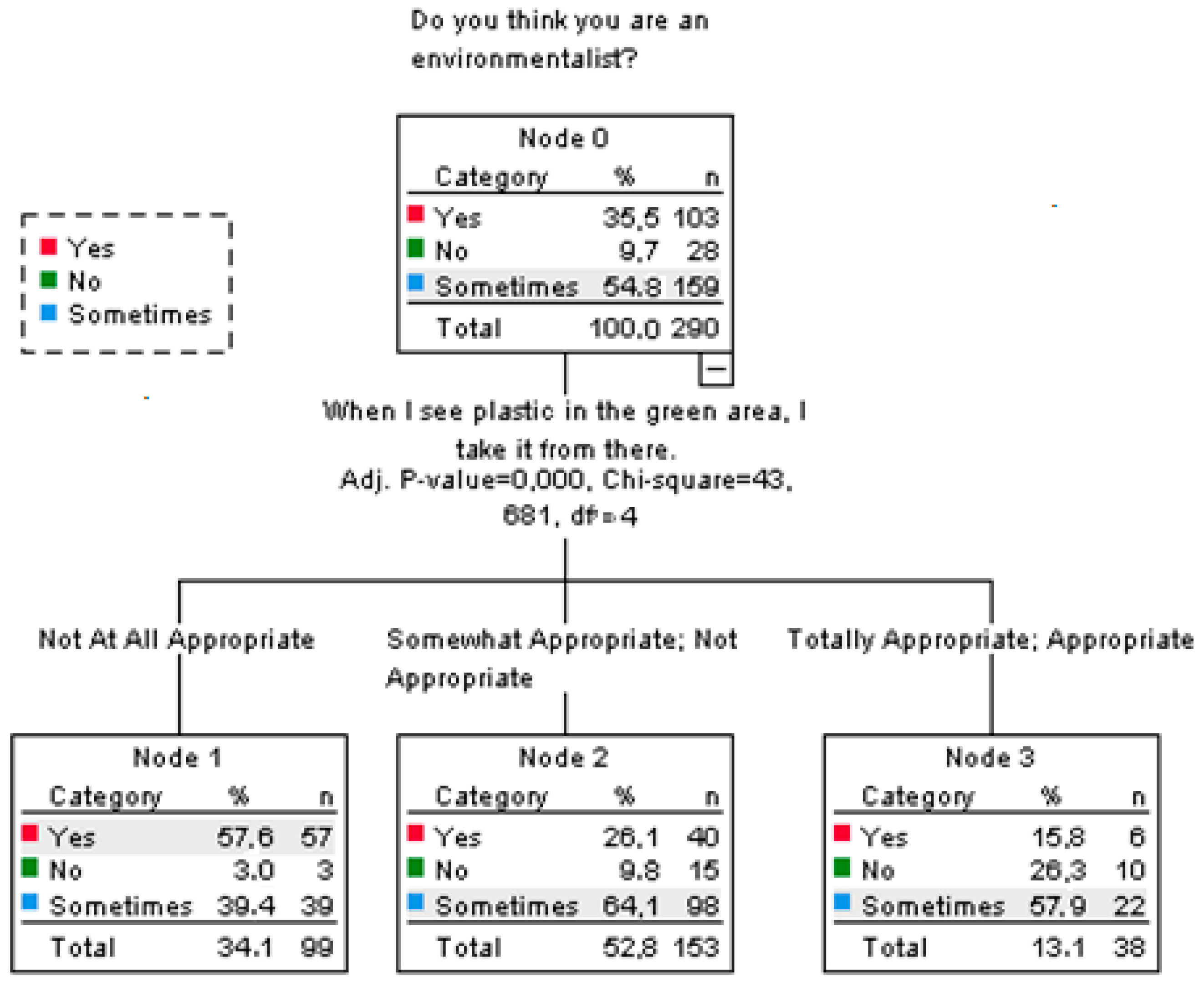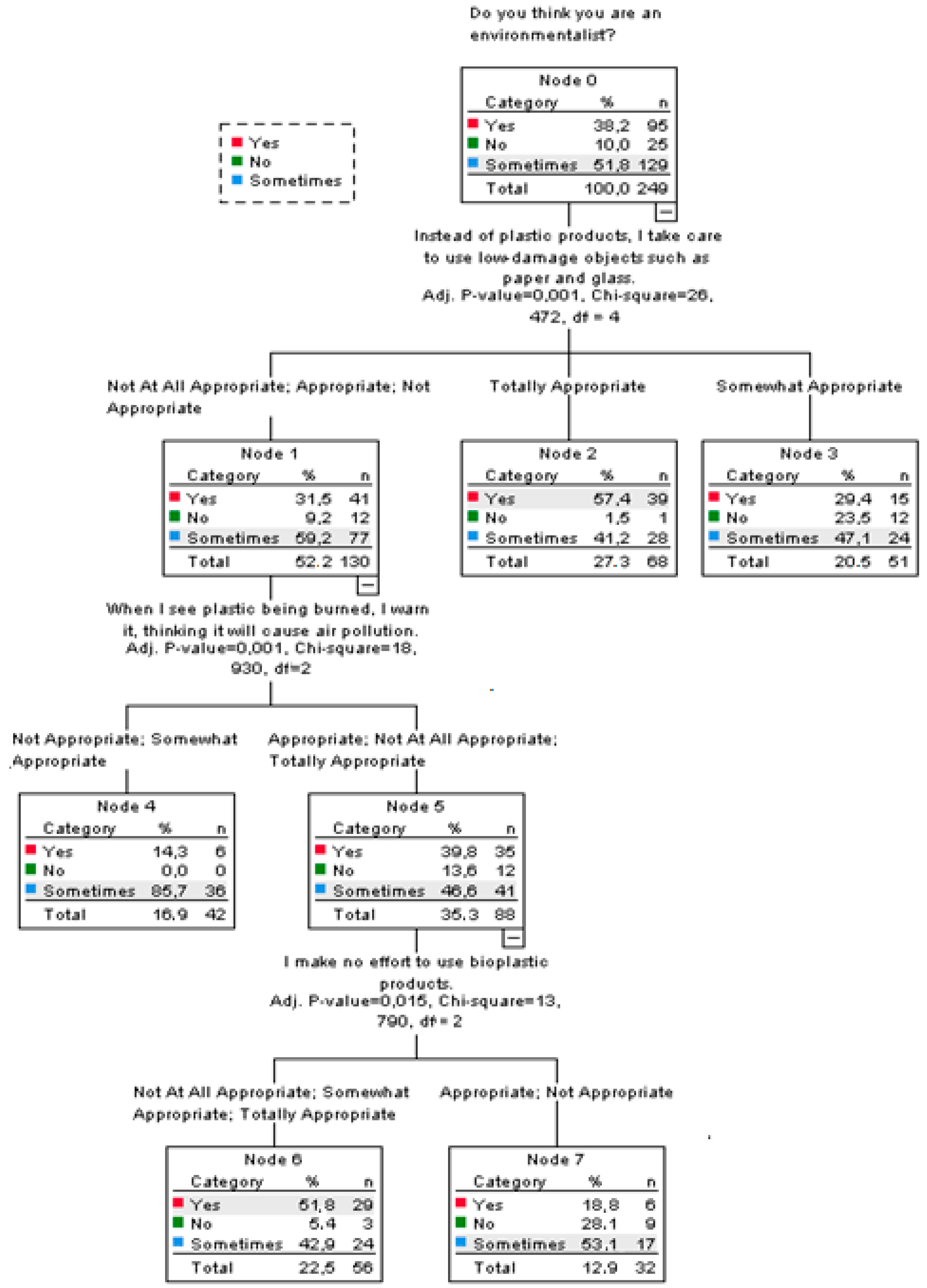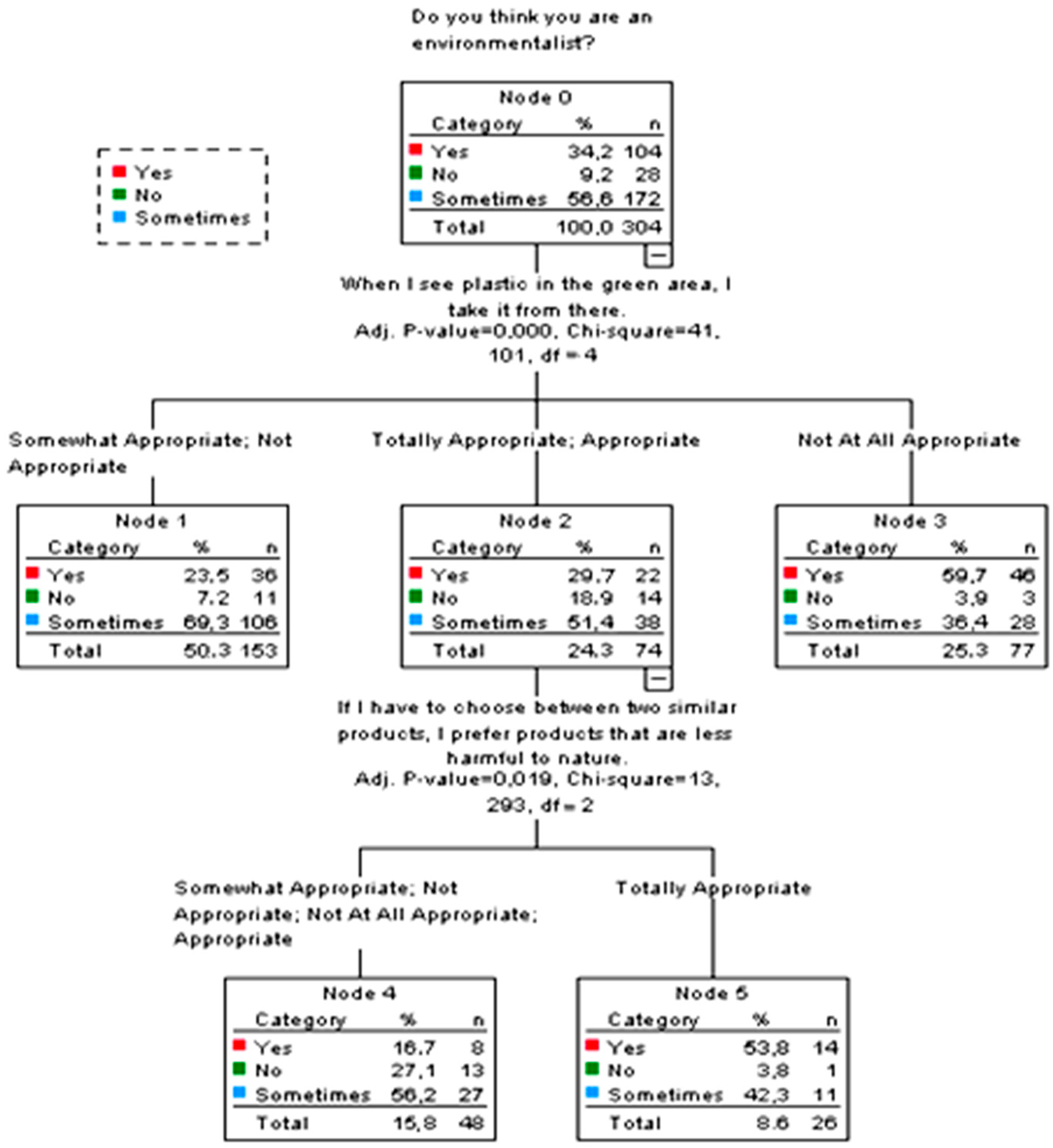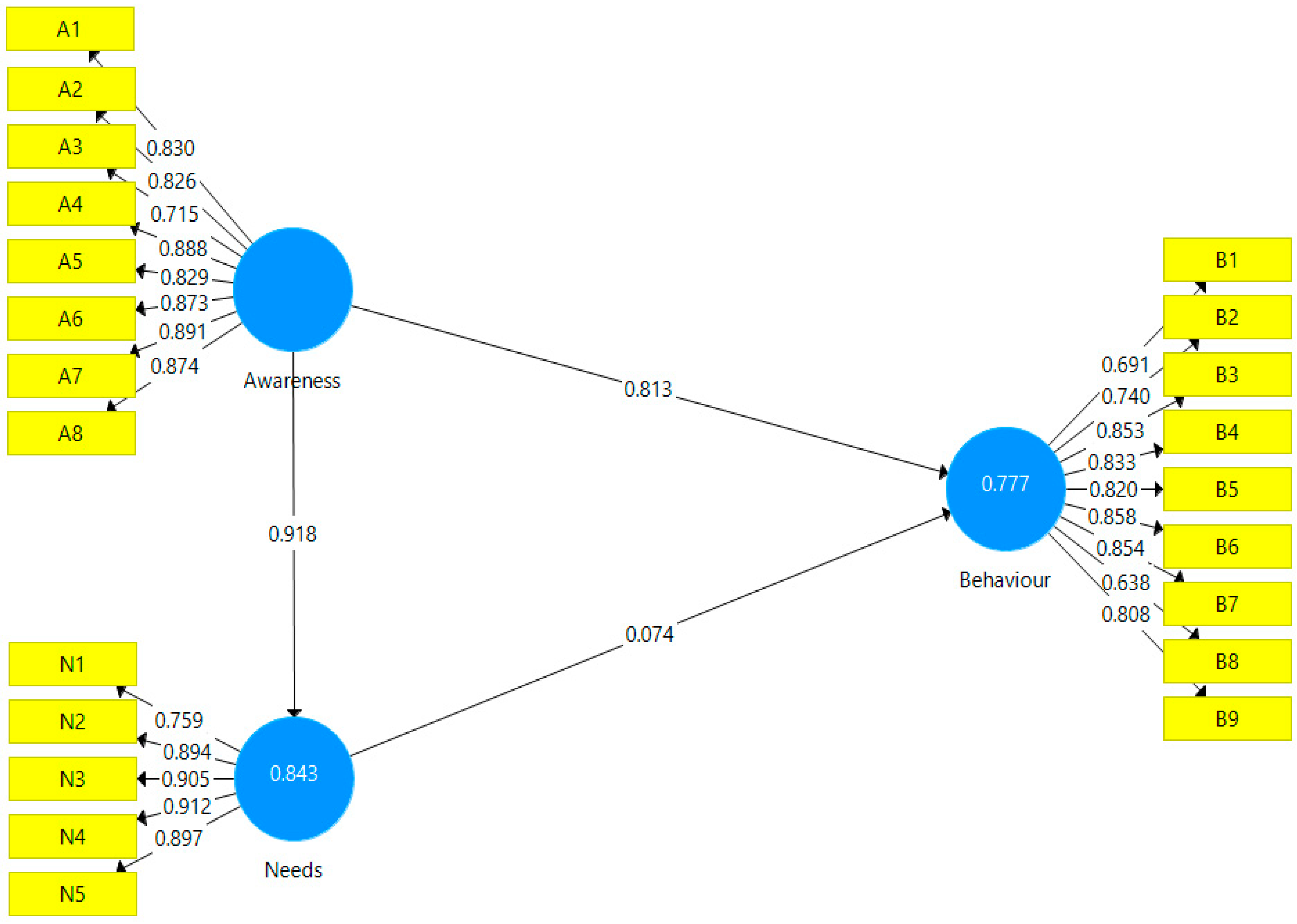Effects of Romanian Student’s Awareness and Needs Regarding Plastic Waste Management
Abstract
1. Introduction
- The selective waste collection process is not sufficiently implemented;
- Insufficient incentives have been adopted to direct waste to recycling;
- Schemes on extended producer responsibility for packaging are not efficient and do not have the capacity to cover the costs of selective collection;
- There is no infrastructure to support selective collection, which makes it difficult for citizens to get involved in this process.
2. Literature Review on Plastic Waste Management
Students’ Attitude and Behavior Regarding Plastic Waste
3. Research Methodology
3.1. Materials and Methods
3.2. Sample and Measurment Tool
- B—students behavior (B1–B9 questions);
- A—students awareness regarding plastic waste (A1–A8 questions);
- N—students needs (N1–N5 questions).
3.3. Evaluation of the Measurement Model
4. Results
4.1. Students Characteristics
4.2. Students Needs
4.3. Students’ Awareness
4.4. Students’ Behavior
5. Discussion
5.1. Correlation between Students’ Awareness Depending on Their Field of Study
5.2. Correlation between Students’ Awareness Depending on Their Gender
5.3. A Cross Model for Students’ Regarding Plastic Waste
5.4. SWOT Analysis for Romanian Students
6. Conclusions
- the lack of concern for this problem, first of all by the shops and then by authorities who do not properly inform about the problem of plastic;
- lack of information is another reason specified by the respondents.
- lack of a separate collection system at the source (at people’s homes) on at least 4–5 types of waste: paper/cardboard, plastic/metal, glass, bio waste (food and vegetable waste) and mixed;
- lack of proper education among the population and decision-makers at central and local level;
- lack of involvement of mayors and failure on their side to assume responsibilities;
- the lack of sanctions and total lack of waste collection in rural areas, where there are no sanitation contracts, which leads most often to pollution either when disposing of them in the wild or when burning uncontrolled.
- creating platforms for courses specific to the field, creating virtual libraries as a source of useful information;
- the transfer of information between different universities or student groups for common research topics.
Limitation of the Study
Author Contributions
Funding
Institutional Review Board Statement
Informed Consent Statement
Conflicts of Interest
References
- NewsWaste Recycling—European Environment Agency. Plastic Waste and Recycling in the EU: Facts and Figures. Available online: https://www.europarl.europa.eu/news/en/headlines/society/20181212STO21610/plastic-waste-and-recycling-in-the-eu-facts-and-figures (accessed on 1 February 2023).
- Plastic Waste and Recycling in the EU: Facts and Figures. Available online: https://www.europarl.europa.eu/news/ro/headlines/society/20181212STO21610/deseurile-din-plastic-si-reciclarea-in-ue-in-cifre (accessed on 13 February 2023).
- Androniceanu, A.; Kinnunen, J.; Georgescu, I. Circular economy as a strategic option to promote sustainable economic growth and effective human development. J. Intern. Stud. 2021, 14, 60–73. [Google Scholar] [CrossRef]
- Legea anti-plastic—Mai bine pentru mediu, mai provocator pentru firme. Available online: https://www2.deloitte.com/ro/ro/pages/tax/articles/legea-anti-plastic-mai-bine-pentru-mediu-mai-provocator-pentru-firme.html (accessed on 16 February 2023).
- Studiu: Alternative pentru o Românie fără plastic—Percepții și comportamente ale românilor. Available online: https://www.invisiblenature.ro/sustainability/studiu-alternative-pentru-o-romanie-fara-plastic/ (accessed on 28 February 2023).
- Pentru un Viitor Nesufocat de Plastic. Available online: https://www.greenpeace.org/romania/articol/4507/pentru-un-viitor-nesufocat-de-plastic/ (accessed on 28 February 2023).
- De Sousa, F.D.B. The role of plastic concerning the sustainable development goals: The literature point of view. Clean. Responsible Consum. 2021, 3, 100020. [Google Scholar] [CrossRef]
- Agenda, 2030. Agenda 2030-SDG14. Available online: http://www.agenda2030.org.br/ods/14/ (accessed on 1 February 2023).
- Yusuf, R.; Fajri, I. Differences in behavior, engagement and environmental knowledge on waste management for science and social students through the campus program. Heliyon. 2022, 8, e08912. [Google Scholar] [CrossRef] [PubMed]
- Liao, C.; Li, H. Environmental Education, Knowledge, and High School Students’ Intention toward Separation of Solid Waste on Campus. Int. J. Environ. Res. Public Health 2019, 16, 1659. [Google Scholar] [CrossRef] [PubMed]
- Situmorang, R.O.P.; Liang, T.-C.; Chang, S.-C. The Difference of Knowledge and Behavior of College Students on Plastic Waste Problems. Sustainability 2020, 12, 7851. [Google Scholar] [CrossRef]
- Harman, G.; Yenikalayci, N. Determination of Science Students’ Awareness on Waste Management. J. Sci. Learn. 2022, 5, 301–320. [Google Scholar] [CrossRef]
- Boston College. Plastic Use and Student Behavior Regarding Reusable Dishware, Olivia Meyer, Natalie Saul, and Colton Cardinal ENVS4943. 2019. Available online: https://www.bc.edu/content/dam/ (accessed on 1 February 2023).
- Uehara, T.; Asari, M.; Sakurai, R. Knowing the rules can effectively enhance plastic waste separation on campus. Front. Sustain. 2022, 3, 1023605. [Google Scholar] [CrossRef]
- Bennett, E.M.; Alexandridis, P. Informing the Public and Educating Students on Plastic Recycling. Recycling 2021, 6, 69. [Google Scholar] [CrossRef]
- Nyavor-Akporyo, A.B.; Kutsanedzie, F.; Achio, S.; Nyame-Tawiah, V.; Appiah Gyekye, L.; Mensah, E. Alternative way of managing plastic waste on campuses. Int. J. Dev. Sustain. 2013, 2, 2176–2187. [Google Scholar]
- Aikowe, L.D.; Mazancová, J. Plastic Waste Sorting Intentions among University Students. Sustainability 2021, 13, 7526. [Google Scholar] [CrossRef]
- Dalu, M.T.B.; Cuthbert, R.N.; Muhali, H.; Chari, L.D.; Manyani, A.; Masunungure, C.; Dalu, T. Is Awareness on Plastic Pollution Being Raised in Schools? Understanding Perceptions of Primary and Secondary School Educators. Sustainability 2020, 12, 6775. [Google Scholar] [CrossRef]
- Kaffashi, S.; Shamsudin, M.N. Transforming to a Low Carbon Society; an Extended Theory of Planned Behaviour of Malaysian Citizens. J. Clean. Prod. 2019, 235, 1255–1264. [Google Scholar] [CrossRef]
- Islam, M.T.; Dias, P.; Huda, N. Young consumers’ e-waste awareness, consumption, disposal, and recycling behavior: A case study of university students in Sydney, Australia. J. Clean. Prod. 2021, 282, 124490. [Google Scholar] [CrossRef]
- Owojori, O.M.; Mulaudzi, R.; Edokpayi, J.N. Student’s knowledge, attitude, and perception (KAP) to solid waste management: A survey towards a more circular economy from a rural-based tertiary institution in South Africa. Sustainability 2022, 14, 1310. [Google Scholar] [CrossRef]
- Árnadóttir, Á.D.; Kok, G.; Van Gils, S.; Ten Hoor, G.A. Waste separation in cafeterias: A study among university students in the Netherlands. Int. J. Environ. Res. Public Health 2019, 16, 93. [Google Scholar] [CrossRef]
- Bashir, M.J.; Jun, Y.; Yi, L.; Abushammala, M.F.; Abu Amr, S.S.; Pratt, L.M. Appraisal of student’s awareness and practices on waste management and recycling in the Malaysian University’s student hostel area. J. Mater. Cycles Waste Manag. 2020, 22, 916–927. [Google Scholar] [CrossRef]
- Prasetiawan, T.; Wasisto, A. Students’ Perceptions and Attitudes in Waste Management: The Role of Internet Literacy and Sustainability Programs. In Proceedings of the Second Asia Pacific International Conference on Industrial Engineering and Operations Management, Surakarta, Indonesia, 14–16 September 2021. [Google Scholar]
- Ranjbari, M.; Esfandabadi, Z.S.; Gautam, S.; Ferraris, A.; Scagnelli, S.D. Waste management beyond the COVID-19 pandemic: Bibliometric and text mining analyses. Gondwana Res. 2023, 114, 124–137. [Google Scholar] [CrossRef]
- Mohamed, B.A.; Fattah, I.M.R.; Yousaf, B.; Periyasamy, S. Effects of the COVID-19 pandemic on the environment, waste management, and energy sectors: A deeper look into the long-term impacts. Environ. Sci. Pollut. Res. 2022, 29, 46438–46457. [Google Scholar] [CrossRef]
- Peng, Y.; Wu, P.; Schartup, A.T.; Zhang, Y. Plastic waste release caused by COVID-19 and its fate in the global ocean. Proc. Natl. Acad. Sci. USA 2021, 118, e2111530118. [Google Scholar] [CrossRef]
- Dowarah, K.; Duarah, H.; Devipriya, S.P. A preliminary survey to assess the awareness, attitudes/behaviours, and opinions pertaining to plastic and microplastic pollution among students in India. Mar. Policy 2022, 144, 105220. [Google Scholar] [CrossRef]
- Qu, D.; Shevchenko, T.; Shams Esfandabadi, Z.; Ranjbari, M. College Students’ Attitude towards Waste Separation and Recovery on Campus. Sustainability 2023, 15, 1620. [Google Scholar] [CrossRef]
- Ilić-Živojinović, J.B.; Ilić, B.; Backović, D.; Tomanić, M.; Gavrilović, A.; Bogdanović, L. Knowledge and attitudes on medical waste management among Belgrade medical and dental students. Srp. Arh. Celok. Lek. 2019, 147, 281–285. [Google Scholar] [CrossRef]
- Victorelli, G.; Flyrio, F.M.; Ramacciato, J.C.; Motta, R.H.L.; de Souza Fonseca Silva, A. Impact of pedagogical method on Brazilian dental students’ waste management practice. J. Dent. Educ. 2014, 78, 1528–1533. [Google Scholar] [CrossRef]
- Ferdous, T.; Das, T. A study about the attitude of grade eight students for the use of plastic in Gwarko, Balkumari, Lalitpur district. Procedia Soc. Behav. Sci. 2014, 116, 3754–3759. [Google Scholar] [CrossRef]
- Fan, B.; Yang, W.; Shen, X. A Comparison Study of ‘Motivation–Intention–Behavior’ Model on Household Solid Waste Sorting in China and Singapore. J. Clean. Prod. 2019, 211, 442–454. [Google Scholar] [CrossRef]
- Khan, F.; Ahmed, W.; Najmi, A.; Younus, M. Managing plastic waste disposal by assessing consumers’ recycling behavior: The case of a densely populated developing country. Environ. Sci. Pollut. Res. 2020, 26, 33054–33066. [Google Scholar] [CrossRef]
- Khan, O.; Daddi, T.; Slabbinck, H.; Kleinhans, K.; Vazquez-Brust, D.; De Meester, S. Assessing the Determinants of Intentions and Behaviors of Organizations towards a Circular Economy for Plastics. Resour. Conserv. Recycl. 2020, 163, 105069. [Google Scholar] [CrossRef]
- Colorado, H.A.; Velásquez, E.I.G.; Monteiro, S.N. Sustainability of additive manufacturing: The circular economy of materials and environmental perspectives. J. Mater. Res. Technol. 2020, 9, 8221–8234. [Google Scholar] [CrossRef]
- Wang, Q.; Zhang, W.; Tseng, C.P.M.L.; Sun, Y.; Zhang, Y. Intention in Use Recyclable Express Packaging in Consumers’ Behavior: An Empirical Study. Resour. Conserv. Recycl. 2021, 164, 105115. [Google Scholar] [CrossRef]
- Shevchenko, T.; Ranjbari, M.; Shams Esfandabadi, Z.; Danko, Y.; Bliumska-Danko, K. Promising Developments in Bio-Based Products as Alternatives to Conventional Plastics to Enable Circular Economy in Ukraine. Recycling 2022, 7, 20. [Google Scholar] [CrossRef]
- Moshood, T.D.; Nawanir, G.; Mahmud, F.; Mohamad, F.; Ahmad, M.H.; AbdulGhani, A. Biodegradable plastic applications towards sustainability: A recent innovations in the green product. Clean. Eng. Technol. 2022, 6, 100404. [Google Scholar] [CrossRef]
- Moshood, T.D.; Nawanir, G.; Mahmud, F.; Mohamad, F.; Ahmad, M.H.; AbdulGhani, A. Sustainability of biodegradable plastics: New problem or solution to solve the global plastic pollution? Curr. Res. Green Sustain. Chem. 2022, 5, 100273. [Google Scholar] [CrossRef]
- Industria Europeană a Plasticului: Sperând la ce e Mai Bine, Pregătindu-se pentru ce e Mai Rău. Available online: https://www.ttonline.ro/revista/materiale-plastice/industria-europeana-a-plasticului-sperand-la-ce-e-mai-bine-pregatindu-se-pentru-ce-e-mai-rau (accessed on 13 February 2023).
- Qin, M.; Chen, C.; Song, B.; Shen, M.; Cao, W.; Yang, H.; Zeng, G.; Gong, J. A review of biodegradable plastics to biodegradable microplastics: Another ecological threat to soil environments? J. Clean. Prod. 2021, 312, 127816. [Google Scholar] [CrossRef]
- Peixoto, D.; Pinheiro, C.; Amorim, J.; Oliva-Teles, L.; Guilhermino, L.; Vieira, M.N. Microplastic pollution in commercial salt for human consumption: A review. Estuar. Coast Shelf Sci. 2019, 219, 161–168. [Google Scholar] [CrossRef]
- Tamburini, E.; Costa, S.; Summa, D.; Battistella, L.; Fano, E.A.; Castaldelli, G. Plastic (PET) vs bioplastic (PLA) or refillable aluminium bottles—What is the most sustainable choice for drinking water? A life-cycle (LCA) analysis. Environ. Res. 2021, 196, 110974. [Google Scholar] [CrossRef]
- Allison, A.L.; Baird, H.M.; Lorencatto, F.; Weeb, T.L.; Michie, S. Reducing plastic waste: A meta-analysis of influences on behaviour and interventions. J. Clean. Prod. 2022, 380, 134860. [Google Scholar] [CrossRef]
- Kumar, R.; Verma, A.; Shome, A.; Sinha, R.; Sinha, S.; Jha, P.K.; Kumar, R.; Kumar, P.; Shubham; Das, S.; et al. Impacts of Plastic Pollution on Ecosystem Services, Sustainable Development Goals, and Need to Focus on Circular Economy and Policy Interventions. Sustainability 2021, 13, 9963. [Google Scholar] [CrossRef]
- Opeolu, O.T. Plastic Waste Awareness and Practices among Students. A Case study of the students of the Faculty of Environmental Sciences, University of Lagos. In Plastic Waste Management in Nigerian Tertiary Institutions; University of Lagos: Lagos, Nigeria, 2021. [Google Scholar]
- Chauhan, N.S.; Punia, A. Role of Education and Society in Dealing Plastic Pollution in the Future; John Wiley and Sons: Hoboken, NJ, USA, 2022. [Google Scholar]
- Sandu, C.; Takacs, E.; Suaria, G.; Florea, L. Society Role in the Reduction of Plastic Pollution. In Plastics in the Aquatic Environment—Part II: Stakeholders Role against Pollution; Springer: Cham, Switzerland, 2020. [Google Scholar]
- Dilkes-Hoffman, L.S.; Pratt, S.; Lant, P.A.; Laycock, B. The role of biodegradable plastic in solving plastic solid waste accumulation. In Plastics to Energy. Fuel, Chemicals and Sustainability Implications; Al-Salem, S.M., Ed.; William Andrew Publishing: Oxford, UK, 2019; pp. 469–505. [Google Scholar]
- Napper, I.E.; Thompson, R.C. Environmental deterioration of biodegradable, oxo-biodegradable, compostable, and conventional plastic carrier bags in the sea, soil, and open-air over a 3-year period. Environ. Sci. Technol. 2019, 53, 4775–4783. [Google Scholar] [CrossRef]
- Barros, M.V.; Puglieri, F.N.; Tesser, D.P.; Kuczynski, O.; Piekarski, C.M. Sustainability at a Brazilian university: Developing environmentally sustainable practices and a life cycle assessment case study. Int. J. Sustain. High Educ. 2020, 21, 841–859. [Google Scholar] [CrossRef]
- Babayemi, J.O.; Nnorom, I.C.; Osibanjo, O.; Weber, R. Ensuring Sustainability in Plastics Use in Africa: Consumption, Waste Generation, and Projections. Environ. Sci. Eur. 2019, 31, 60. [Google Scholar] [CrossRef]
- Van Rensburg, M.L.; S’phumelele, L.N.; Dube, T. The ‘plastic waste era’; social perceptions towards single-use plastic consumption and impacts on the marine environment in Durban, South Africa. Appl. Geogr. 2020, 114, 102132. [Google Scholar] [CrossRef]
- Dagiliute, R.; Liobikiene, G. University Contributions to Environmental Sustainability: Challenges and Opportunities from the Lithuanian Case. J. Clean. Prod. 2015, 108, 891–899. [Google Scholar] [CrossRef]
- Fissi, S.; Romolini, A.; Gori, E.; Contri, M. The Path toward a Sustainable Green University: The Case of the University of Florence. J. Clean. Prod. 2021, 279, 123655. [Google Scholar] [CrossRef]
- Hair, J.F.; Ringle, C.M.; Sarstedt, M. PLS-SEM: Indeed a silver bullet. J. Mark. Theory Pract. 2011, 19, 139–152. [Google Scholar] [CrossRef]
- Ringle, C.M.; Wende, S.; Becker, J.-M. SmartPLS3. Boenningstedt: SmartPLS GmbH. 2015. Available online: http://www.smartpls.com (accessed on 16 January 2023).
- Sarstedt, M.; Ringle, C.M.; Smith, D.; Reams, R.; Hair, J.F., Jr. Partial least squares structural equation modeling (PLS-SEM): A useful tool for family business researchers. J. Fam. Bus. Strategy 2014, 5, 105–115. [Google Scholar] [CrossRef]
- Hair, J.F., Jr.; Hult, G.T.M.; Ringle, C.M.; Sarstedt, M. A Primer on Partial Least Squares Structural Equation Modeling (PLS-SEM); Sage Publications: Newbury Park, CA, USA, 2017. [Google Scholar]






| Factor/Item | Factor Loading | Cronbach’ α | rho_A | CR | AVE |
|---|---|---|---|---|---|
| Awareness | 0.941 | 0.943 | 0.951 | 0.710 | |
| A1 | 0.830 | ||||
| A2 | 0.826 | ||||
| A3 | 0.715 | ||||
| A4 | 0.888 | ||||
| A5 | 0.829 | ||||
| A6 | 0.873 | ||||
| A7 | 0.891 | ||||
| A8 | 0.874 | ||||
| Needs | 0.922 | 0.923 | 0.942 | 0.766 | |
| N1 | 0.759 | ||||
| N2 | 0.894 | ||||
| N3 | 0.905 | ||||
| N4 | 0.912 | ||||
| N5 | 0.897 | ||||
| Behavior | 0.924 | 0.933 | 0.937 | 0.627 | |
| B1 | 0.691 | ||||
| B2 | 0.740 | ||||
| B3 | 0.853 | ||||
| B4 | 0.833 | ||||
| B5 | 0.820 | ||||
| B6 | 0.858 | ||||
| B7 | 0.854 | ||||
| B8 | 0.638 | ||||
| B9 | 0.808 |
| Factor/Item | Awareness | Needs | Behavior |
|---|---|---|---|
| Awareness | |||
| A1 | 0.830 | 0.748 | 0.830 |
| A2 | 0.826 | 0.716 | 0.812 |
| A3 | 0.715 | 0.643 | 0.702 |
| A4 | 0.888 | 0.838 | 0.737 |
| A5 | 0.829 | 0.717 | 0.718 |
| A6 | 0.873 | 0.829 | 0.701 |
| A7 | 0.891 | 0.851 | 0.732 |
| A8 | 0.874 | 0.826 | 0.701 |
| Needs | |||
| N1 | 0.731 | 0.759 | 0.748 |
| N2 | 0.814 | 0.894 | 0.703 |
| N3 | 0.823 | 0.905 | 0.723 |
| N4 | 0.828 | 0.912 | 0.715 |
| N5 | 0.813 | 0.897 | 0.697 |
| Behavior | |||
| B1 | 0.582 | 0.544 | 0.691 |
| B2 | 0.610 | 0.548 | 0.740 |
| B3 | 0.767 | 0.710 | 0.853 |
| B4 | 0.724 | 0.669 | 0.833 |
| B5 | 0.729 | 0.695 | 0.820 |
| B6 | 0.772 | 0.725 | 0.858 |
| B7 | 0.783 | 0.759 | 0.854 |
| B8 | 0.530 | 0.462 | 0.638 |
| B9 | 0.726 | 0.666 | 0.808 |
| Gender | F | M | Total | |
|---|---|---|---|---|
| Have you attended a conference on nature conservation before? | Yes | 61 | 71 | 132 |
| No | 172 | 233 | 405 | |
| Total | 233 | 304 | 537 | |
| Do you think you are an environmentalist? | Yes | 93 | 104 | 197 |
| No | 25 | 28 | 53 | |
| Sometimes | 115 | 172 | 287 | |
| Total | 233 | 304 | 537 | |
| Did you take part in environmental activities organized within the university? | Yes | 54 | 97 | 151 |
| No | 178 | 207 | 386 | |
| Total | 233 | 304 | 537 | |
| In Which Department Do You Study? | Total | |||||
|---|---|---|---|---|---|---|
| Automation | IT | Management/Business | Electrical | |||
| Did you take part in environmental activities organized within the university? | Yes | 48 | 42 | 20 | 41 | 151 |
| No | 66 | 47 | 229 | 45 | 386 | |
| Total | 114 | 89 | 249 | 85 | 537 | |
| Have you attended a conference on nature conservation before? | Yes | 26 | 25 | 50 | 31 | 132 |
| No | 88 | 64 | 199 | 54 | 405 | |
| Total | 114 | 89 | 249 | 85 | 537 | |
| I know that petroleum product (plastics) take a long time to biodegrade? | Yes | 96 | 79 | 219 | 67 | 461 |
| No | 7 | 4 | 10 | 6 | 27 | |
| No idea | 11 | 6 | 20 | 12 | 49 | |
| Total | 114 | 89 | 249 | 85 | 537 | |
| Do you think you are an environmentalist? | Yes | 48 | 24 | 95 | 30 | 197 |
| No | 9 | 13 | 25 | 6 | 53 | |
| Sometimes | 57 | 52 | 129 | 49 | 287 | |
| Total | 114 | 89 | 249 | 85 | 537 | |
| N1 | I would like to get new information about the use of bioplastic products. |
| N2 | Bioplastics should replace conventional polymers in the future. |
| N3 | I think that all kinds of studies on the pollution of traditional plastic products should be increased. |
| N4 | I think that bioplastics should be used in mass social events. |
| N5 | I think that bioplastics should be used in takeaway products. |
| A1 | I prefer products that are less harmful to nature |
| A2 | I use low-damage objects such as paper and glass. |
| A3 | I recognize the bioplastic logos on the products. |
| A4 | I prefer the products obtained from the bioplastics industry because they are renewable. |
| A5 | I prefer to avoid products that increase global warming. |
| A6 | I prefer bioplastic products because they do not harm nature when they decompose. |
| A7 | I prefer bioplastic products as they do not harm human health when degraded. |
| A8 | I prefer bioplastic products because they degrade earlier in nature. |
| B1 | I buy bioplastic products, even if they are expensive. |
| B2 | When I see plastic being burned, I report it, thinking it will cause air pollution. |
| B3 | I use bioplastic bags for my grocery shopping. |
| B4 | I make an effort to use a small number of bags in my daily life. |
| B5 | I do not throw plastic products into nature. |
| B6 | I throw the recycling products into the relevant boxes. |
| B7 | I use mesh/cloth/paper bags instead of using disposable bags while shopping. |
| B8 | I inform the people around me about the use of bioplastic products. |
| B9 | When I see plastic in the green area, I take it from there. |
| Relationship | β | t Value | p Value |
|---|---|---|---|
| A → N | 0.918 | 111.09 | 0.000 |
| A → B | 0.813 | 12.21 | 0.000 |
| N → B | 0.074 | 0.97 | 0.33 |
| STRENGTHS | B I O P L A S T I C | WEAKNESSES |
| Universities; Student Information; Specialists in field; Interest; Mass media | No interest; Social law missing; Not observing the rules; Costs are high; Difficulties in implementation; Difficulties to follow the EU rules | |
| OPPORTUNITIES | THREATS | |
| Green University Special Platform with information; Courses online; Playing by doing in the virtual world; Exchange of staff and students and of good practices Books and Virtual library; Curricula; Workshops and conferences Bilateral agreements Transfer of research ideas Dissemination of 3R’s Volunteer activities Teams involve in research activities | People and their indifference; Resistance to change encouraged by keeping people; The refusal of impeachment. |
Disclaimer/Publisher’s Note: The statements, opinions and data contained in all publications are solely those of the individual author(s) and contributor(s) and not of MDPI and/or the editor(s). MDPI and/or the editor(s) disclaim responsibility for any injury to people or property resulting from any ideas, methods, instructions or products referred to in the content. |
© 2023 by the authors. Licensee MDPI, Basel, Switzerland. This article is an open access article distributed under the terms and conditions of the Creative Commons Attribution (CC BY) license (https://creativecommons.org/licenses/by/4.0/).
Share and Cite
Boca, G.D.; Saraçli, S. Effects of Romanian Student’s Awareness and Needs Regarding Plastic Waste Management. Sustainability 2023, 15, 6811. https://doi.org/10.3390/su15086811
Boca GD, Saraçli S. Effects of Romanian Student’s Awareness and Needs Regarding Plastic Waste Management. Sustainability. 2023; 15(8):6811. https://doi.org/10.3390/su15086811
Chicago/Turabian StyleBoca, Gratiela Dana, and Sinan Saraçli. 2023. "Effects of Romanian Student’s Awareness and Needs Regarding Plastic Waste Management" Sustainability 15, no. 8: 6811. https://doi.org/10.3390/su15086811
APA StyleBoca, G. D., & Saraçli, S. (2023). Effects of Romanian Student’s Awareness and Needs Regarding Plastic Waste Management. Sustainability, 15(8), 6811. https://doi.org/10.3390/su15086811








